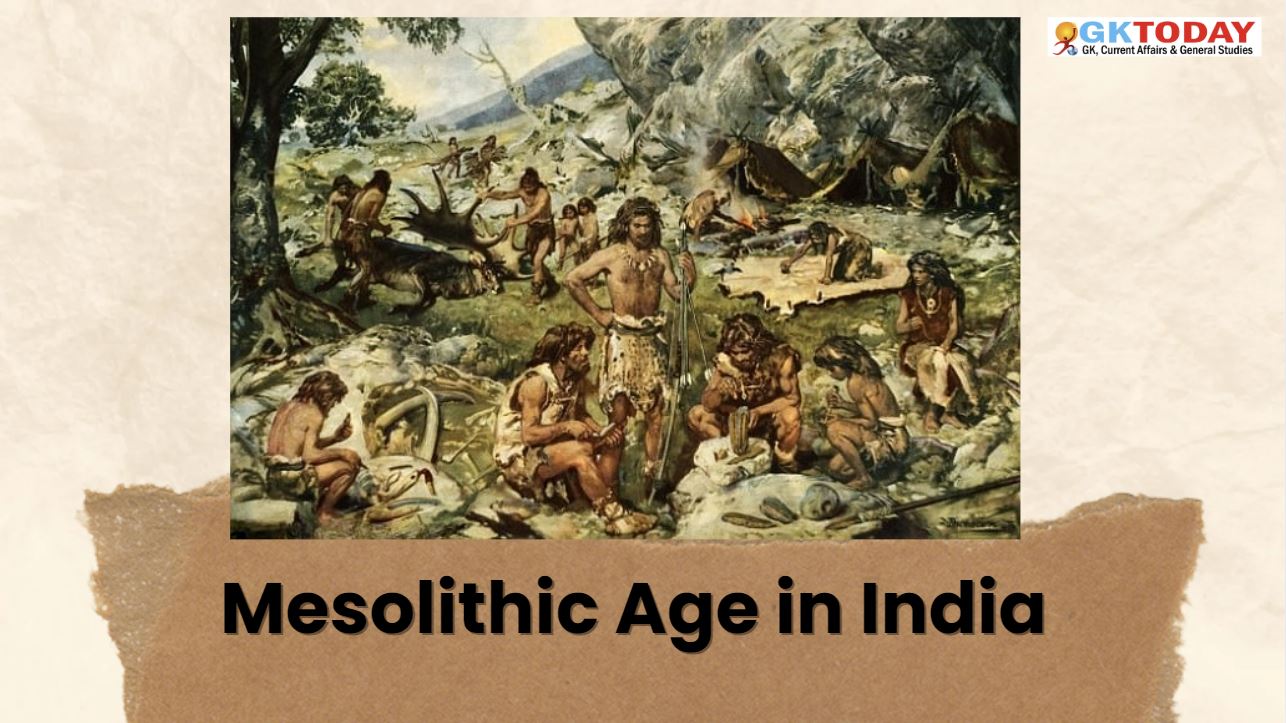Mesolithic Age in India
The transition from the Palaeolithic period to Mesolithic period is marked by transition from Pleistocene period to Holocene and favourable changes in the climate. The climate became warmer and humid and there was expansion of flora and fauna contributed by increased rainfall. This led to availability of new resources to humans.
Tools of Mesolithic Era
The Mesolithic tools smaller in size and better in finishing (more geometric) than the Palaeolithic age and are called Microliths. These microliths are tiny tools of one to five centimetres length, made by blunting one or more sides with steep retouch.

The main tool types are backed blades, obliquely truncated blades, points, crescents, triangles and trapezes. Some of the microliths were used as components of spearheads, arrowheads, knives, sickles, harpoons and daggers. They were fitted into grooves in bone, wood and reed shafts and joined together by natural adhesives like gum and resin. Use of bow and arrows for hunting has been documented by Mesolithic man in rock art of that period. The Bored stones, which had already appeared during the upper Palaeolithic, became common during this, and the Neolithic and Chalcolithic periods. These are believed to have been used as weights in digging sticks and as net sinkers. Similarly, shallow querns and grinding stones also occur at several sites. These new technological elements led to enhanced efficiency in hunting, collection and processing of wild plant foods.
Changes in Life in Mesolithic Era
Domestication of Plants and Animals
The economy of early period of Mesolithic age was based on hunting, fishing and food gathering. Slowly domesticating crops and animals made their way into human life. By 6000 BC, food production became prominent part of Mesolithic life. Agriculture had not fully developed by was only a prototype of domestication of crops and animals. The earliest evidence of domestication of animals has been provided by Adamagarh in Madhya Pradesh and Bagor in Rajasthan. Some examples of earliest cultivation of plants around 7000-6000 years back have been found near Sambhar lake in Ajmer Rajasthan, Mehrgarh in Pakistan etc.
The first animals to be domesticated were dog, cattle, sheep and goat and the first plants to be cultivated were wheat and barley. This new subsistence economy based on food production had a lasting impact on the evolution of human society and the environment. In the humid lands, extending from the middle Ganga valley to China and Southeast Asia, rice cultivation and domestication of pig was accomplished probably around the same time because rice and pig existed in wild form in this region. The cultivation of yams and taro also took place in this region. Domesticated animals proved to be useful not only for meat but also for milk, hide, agricultural operations, and transport.
Nomadism to Sedentary settlements
The favourable climate, better rainfalls, warm atmosphere and increased food security led to reduction in nomadism to seasonally sedentary settlement and increased population. They moved to new areas such as nearby rivers which provided water. First human colonization of the Ganga plains took place during this period.
Disposal of dead and making of Graves
The sedentary settlements lead to beginning of the tradition of various ways of intentional disposal of the dead. The first evidence of intentional disposal of the dead comes from Mesolithic Era. Mesolithic human burials have been found at Bagor in Rajasthan, Langhnaj in Gujarat, Bhimbetka in Madhya Pradesh etc. The dead were buried in graves both in extended and crouched position {in crouched position knees are bent and the upper body is brought forward and down}. In some cases two individuals were buried in a single grave. The dead were occasionally provided with grave offerings which include chunks of meat, grinding stones, stone, bone and antler ornaments, and pieces of haematite.
Mesolithic Art
The Mesolithic man was a lover of art, evident from the paintings in several thousand rock shelters in the Vindhyan sandstone hills in central India. The paintings have been found in both inhabited and uninhabited shelters. The paintings are made mostly in red and white pigments, made from the nodules found in rocks and earth. The subject matter of the paintings are mostly wild animals and hunting scenes, though there are some related to human social and religious life such as sex and child birth. These Rock arts are paintings {petrographs} and engravings {petroglyphs} done in rock shelters or natural caves. In India also, most of the rock art, especially paintings and carvings, have been known to exist from the Mesolithic Age, which continued to Neolithic Age, Iron Age and early historic period. This art not only reflects the cultural life of the times but also a fine aesthetic sense comparable to modern paintings.
Important Mesolithic Sites
- In Rajasthan, Bagor is almost largest Mesolithic site in India. Other major Mesolithic sites in Rajasthan are Tilwara, Pachpadra basin and Sojat Area etc.
- In Guajarat, mesolithic sites include those on banks of river Sabarmati asuch as Akhaj, Valsana, Hirpur, Langhanj etc.
- In Uttar Pradesh, Sarai Nahar Rai, Morhana Pahar and Lekkahia are important Mesolithic sites.
- In Madhya Pradesh, Bhimbetka along with Adamgarh, Chaturbhujnath Nala are major Mesolithic sites.
- In Jharkhand Chhota nagpur plateau is a major Mesolithic site in India.
- In Odisha, Mayurbhanj, Keonjhar, Sundergarh are major mesolithic sites.
- In South India, Mesolithic sites are abundant in Karnataka, Tamil Nadu and Andhra Pradesh.



DrHirenSavaliya
December 13, 2014 at 1:11 amAgain it is very nice & precise.
saurabh singh
February 26, 2015 at 5:40 pmBrillent, most satisfactory content.
arun987
June 5, 2015 at 7:42 amits exellent perfect task
debojyoti
December 20, 2015 at 9:15 pmwhy is there no date as middle stone
period of extent?